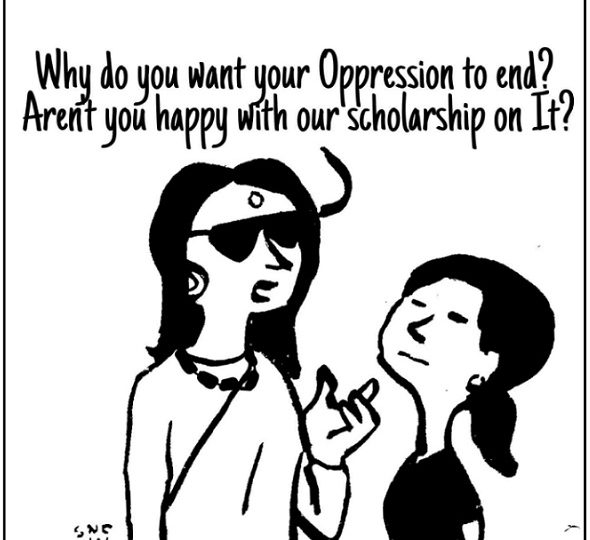Kanika S
There was a time some 5-6 years ago when feminism tried to undermine Dr Ambedkar by pointing out that he carried a penis.1 Now he is just as fantastically a carrier of feminist ideals because his work helped women achieve voting rights, property rights, divorce rights, etc.2,3,4 And that alone is a sufficient criterion for the feminist movement to present him as the face of (any strand of) feminism – a completely separate social movement with its own origin story, specific goals and cultural history1,5. In this article I want to highlight the incoherency of feminist politics in the Indian society, and raise questions on the compatibility of feminism with the goals of an equal society as envisioned by anti-caste movement.

Moral bankruptcy of feminist politics
Let’s start with consent. Feminist movement has historically focused on informed consent (in terms of sexual relations at least) to protect and promote the autonomy of an individual. Yet, in practice the propagators of feminism fail to take informed consent before using someone to represent their politics. Many dead people who are anti-caste icons, like Dr Ambedkar, who can’t give or deny consent are routinely used by feminists for the propagation of feminism. Ironically, this inability to give consent doesn’t make such acts immoral to the feminist consciousness. This ahistorical appropriation is not only happening in India but around the world in many societies.9 This is the primary growth strategy for feminism’s seemingly large global presence.
A moneyed global movement like feminism wants universal adoption and legitimacy everywhere – including Bahujan spaces in India. It is broadly a civilizing mission, like Christianity, telling women what they should need/want/reject and all men how they should behave with women. The latter half in practice is useful guide for men looking to maximize chances to get laid by making themselves appear better than others in view of a feminist woman. Many women in urban spaces have fallen prey to such tricks especially in woke circles – there is ample documentation available on this.
Global feminist demands include adoption of feminist terminologies and tools without any real engagement with other stratifications in a society. One ought to have globally approved parameters to judge their local cultural contexts on its misogyny, one ought to know the right terminology and know the nuances written in academic or popular literature by the earlier feminists to orient themselves on how to identify and articulate on patriarchy or misogyny. Armed with this exported knowledge a feminist is let loose on her/his local society to theorize their realities in terms that the global feminist community can understand. Whether majority of that society can process and use feminism to improve their lived reality is much less important. In this way, feminism is fashioned as a universal medicine for all societies, somewhat like steroids. An internationally oriented movement cannot wait to study the specific cultures of 190+ nations and bet their future political existence on all or most of them having a common global problem. It is much easier to observe some 5-7 countries and theorize, and then declare that theory globally useful.
In India, no feminist has ever taken the responsibility to build on what Babasaheb wrote about the role of women in Indian society – as outlined in Castes in India or Riddles in Hinduism or in any of his other texts that dealt with the role of women in Indian society. Indian feminist articulation on the category of ‘women’ has been articulated by completely ignoring the insights given by Babasaheb. He articulated at length on how violent cultural practices to control the womb of caste-Hindu women like Sati, child marriage, enforced widowhood, was practiced to rabidly maintain caste boundaries – by managing surplus women in a caste. But now it seems from feminist articulations that the most horrific gendered violence has vanished completely from within those families. Caste still exists but its mechanism of propagation has been diminished significantly. The worst violence is now unleashed on the category of ‘Dalit women’. How can things change so drastically within less than 100 years? Feminists evade the responsibility to explain that discrepancy by completely ignoring such writings. But they are eager to coopt Babasaheb – or the Phule couple – as feminist icons! This could be rewarding since the people who are already familiar with those faces can then also become subscribers of feminist morality – and won’t be able to challenge its logic. Feminism can then advance its own elite goals with legitimacy from Bahujan communities. For example, Savarna feminists can then get them to advance their goal of gender equality on the board of Tata Group or Vedanta. What the existence of either of the two does to Adivasi-Dalit communities is too local to matter in the global clamor for gender equality in all places.
In search of a ‘feminist’ consumer
In business lingo, a consumer is the one who pays to consume the goods and services produced by a producer. As such, consumers play a vital role in the economic system. In the absence of their effective demand, the producers would lack a key motivation to produce, which is to sell to consumers (and profit off them). In our context, White/Brahmin women are the sellers, feminism is the product/service, and women from all castes & tribes are its consumers. As in case of other goods & services, marketers of feminism as well are paying close attention to consumer behavior or how potential buyers act when subscribing into feminism for personal consumption. This has led to the emergence of Muslim feminism, Dalit feminism, Adivasi feminism though still not Brahmin feminism or Thakur feminism or Khatri feminism.1,5,7 This is primarily because the second category of women are much more pitiably dependent on their caste men to lead aristocratic lifestyles to which they feel entitled, so there is a fear of loss of material privilege. Secondarily it is not politically lucrative in a democratic order to pander to these numerically small communities. So, it is imperative to go for a universal conception of women and feminism that are shaped first in the image of aristocratic women and then flavored with minor modifications to sell to numerically vast communities.
Adoption of feminist sensibilities will make it easier to discipline communities who neither have enough leisurely time nor access nor interest (this matters the least) to adequately fashion themselves in feminist etiquettes.5 It will also give the discourse setters a vast political base to call upon when they want to center a particular issue. We see this happen time and again in selection of sexual crimes to nationalize and labour for – Nirbhaya in Delhi or the Reddy women in Hyderabad are the right representatives of ‘women’ bodies. Indian penal law is for commoners, for these special victims revengeful and illegal responses can now be legitimately channeled against the accused because the feminist angst can better dress up ‘caste dishonoring’ that has always been associated with rapes in Indian society. There are many old Bollywood films that have depicted this Savarna association of rape and honor of the victim’s family/caste. For instance, consider this Bollywood production by a Brahmin man released in the year 2000 – Humara Dil Aapke Paas Hai. Inspired by the Telugu film, “Pelli Chuskundam,” the plot follows the life of a rape victim (Aishwarya Rai); now, a disgrace to her Brahmin family & Dwij caste neighborhood, she is turned away from her house after the sexual assault. Also, not coincidentally, the surname of the rapist villains is the one that is typically a Bahujan family title – used by Jaats as well as other Bahujan families in North India. There are many such works a look at which will prove the point that caste purity is maintained through sexual contacts deemed caste appropriate, and sexual assault is perceived as pollution of the victims – who are not mere individuals like in the American society but embodiments of their family names or castes.
Caste management
Let’s come to who feminism is propagated through in the Indian society. Anu Ramdas in her article5 examines literary evidence to point where feminism originated first – the Christian West. It is also true that not all knowledge by the same society is discarded by us. However, it is not just that the context in which it was borne that is inapplicable to Indian subcontinent, it is also how feminism is spread globally. It is mostly in university spaces or corporate sectors where someone from a rural district will first be socialized in feminist etiquettes. These are the spaces that are strictly under Brahmin-Dwij control. This class is the one that is best equipped to position themselves to benefit most from the exported jobs & business ideas from the West, as well as the exported politics and social movements from the West.
Owing to colonial loot globally & feudal loot locally, feminism is at least 100X more resourceful and powerful as a movement than anti-caste movement in India, so it isn’t very difficult to gaslight Bahujans strategically to make feminists out of them. Methodology to achieve this is simply assigning the label of feminist to Babasaheb or Savitri Phule or Mayawati or any other Bahujan person who gets famous next. Any Bahujan icons who worked for the rights of women at any point in their life are now posthumously baptized as feminist heroes by anyone socialized in the Brahmin-Dwij regulated spaces, even if these icons spent most of their lives dealing with the monster of caste. As if, for the world to make sense, nothing could be done in the interests of women before the idea of feminism was born. This frees the modern-day Indian feminists of laboring to articulate and gain legitimacy independently in their own society, or even from theorizing on their patriarchies based in real life. It gives them access to a readymade history to lay claim to without having to dishonor their families or caste groups by giving the true specifics.
Since the object of feminism is mere gender equality within every social class of every society, in mainstream Indian life, feminism reproduces caste hierarchies (just like organized religions do13) when it comes to material gains like jobs, inheritance, funding allocation, representation in public offices or incarceration in jails. Which is why the ruling class households adopt it almost naturally. I want to pose this question to the Bahujans once again: Is the anti-caste mission then compatible with an ideology that systematically allocates material gains in line with caste-based hierarchies with a renewed morality previously offered by philosophy of Hinduism5? Especially when it is much more powerful than contemporary anti-caste movements?
Birth of ‘women community’
Jenny Rowena in this article10 tells us something very crucial: “as modernity was ushered in, the savarna communities transformed themselves into the broad category of the ‘Indian’ or ‘Malayali’ and thus they did not have to bear the burden of their communities, or the patriarchy associated with the community.” She expands on how Savarna women have escaped the responsibility to honestly represent the caste-patriarchies of their respective communities. This they’ve done by presenting women as a community unto themselves, rather than being female members of their respective families that cumulate into castes. Women might share some commonality in terms of biology or sexuality or in gendered family roles, but this is where the commonality ends. Where they live, eat, sleep, shop, shit, work, marry, reproduce, travel; what they consume or produce or lack; all of that is a function of their immediate families and castes primarily.
When the basic unit of society is family – whether joint or nuclear – there is a potential to double material gains for a family by allowing women same rights as men professionally. It is for this basic reason that vast majority of women have been working, since forever, in the fields as famers, as construction labour, as cooks, as weavers, as potters, as beauticians, housekeepers, midwives, small shopkeepers, etc. There is a large female workforce that is employed in the informal sector which both Indian State and Indian Feminist movement are equally blind towards. But the hypervisible feminist movement only moves into action when an actor politician talks about wages for housewives for keeping the house.12
Women, Feminism, and the Indian economy
Kuffir points out in his paper how Brahmin & allied castes take their traditional surpluses into organized sector to wield an even larger control over the Indian economy11 – “urban assets and jobs are the contemporary form of fiefs which the Indian state and society have made available to the Brahmins and upper caste.” This minuscule formal sector is the main concern of the feminist movement as well. The global feminist movement owing to its place of origin is oriented to only understand and deal with this part of the social demographic and economy. The West doesn’t have an unorganized sector, whatever economic arrangements they had has been theorized and organized through capitalist economic theories. India doesn’t enjoy this privilege. The Brahmin-Dwij class migrated to formal sector through government jobs in socialist Indian State and through corporate jobs since 1990s.14 Leaving behind vast majorities – most of who are Bahujans – in what they call the unorganized or informal sector.
According to ILO, India has 92% workers in the informal sector. Consider these numbers from MOSPI (2011). Workforce Participation rate for females is significantly higher at 41.8% in rural areas against urban participation rate of 35.31%. In Himachal Pradesh, workforce participation rate for female is highest (44.82%), whereas the same is lowest in Delhi (10.58%) among States/UTs. Still the Brahmin feminist has no reason to shift her gaze to the part of the economy even when it has the largest female presence – since she doesn’t have to survive through working there. Nor the global White feminist could decipher this kind of labour or lifestyle of a common Indian woman. So, the Indian feminists focus on what the White feminist can understand and help with – the organized economy and metropolitan life.
The property rights given by “feminist” Babasaheb are widely used to evade taxes by the rich Dwija business families in metro cities. Many *allow* their women to have careers by opening NGOs or own secondary businesses/shops for the same reason – preservation of wealth. For the salaried ruling class, feminism has about doubled many family incomes by opening the organized job market for Dwija women as well as the men. Yet this is a tiny minority within Dwija population.6 Most times, the organized job market, it seems, isn’t even offering wages lucrative enough for Savarna women to not be a housewife and work for someone else using their education. In fact, being housewives is such a privilege that the Indian ruling class has refused to ever enumerate the exact number of women who are just housewives in India. Currently accepted practice is to underestimate the actual female labour force participation by counting women workers as workers selectively and declare the rest of the pie as full-time homemakers. Whether or not that is an economically viable option for majority families struggling to make ends meet or not matters little. Data doesn’t have to actually make sense to be published and cited by apex Indian institutions; unlike most, we are free of those kinds of worldly restrictions.8
Coming to the case of Bahujans, feminism offers only justice for sexual violence, and even on this count it fails to force the hand of police or judiciary. The field of political gains for Bahujan women is restricted to their homes7 without promises of capital gains through formalizing their wage rates or putting safety nets in places of their work. They have nothing else to offer the overwhelming majority of the Indian women. Only a minuscule number of Bahujan women can secure the organized sector jobs which again is secured largely because of educational opportunities secured through Constitution, not feminism. Other Bahujan women who have been laboring for Dwija properties are already ‘enjoying’ their right (or rather duty) to work, and right to property(lessness) in the service of Dwijas’ resource hoarding or surplus accumulation.
Some parting questions
So why are Bahujan women expected to adopt feminism? Is it lucrative to be a Bahujan man in this world? What does he own that we don’t and should want to own as well? One could consider the subscription offer if they are promised what Brahmin men have. But feminism is quiet obviously incapable of getting Bahujan women that. We’re just numbers to amplify Brahmin-Dwija women’s demands in their negotiation with their male counterparts for equal power holding using feminist articulations. It makes much more sense to take away the whole Brahmin class’ excess powers, instead of laboring to settle their disputes for a happier Brahmin-Dwij family experience while enjoying the usurped surplus from Bahujans, no?
This article was first published in SAVARI.
~
References
1. Sruthi Herbert. How Did We Get Here?; http://www.dalitweb.org/?p=2893
2. https://www.thequint.com/voices/opinion/ambedkar-feminism-women-empowerment-indian-women-right-to-vote-divorce-property-rights-gender-equality#read-more
3. https://www.epw.in/journal/2020/1/alternative-standpoint/ambedkars-feminism.html
4. https://www.outlookindia.com/website/story/opinion-the-urgency-of-engaging-in-babasaheb-ambedkars-thought-for-dalit-feminist/380148
5. Anu Ramdas. Feminism is Brahminism; https://roundtableindia.co.in/index.php?option=com_content&view=article&id=9928:feminism-is-brahminism&catid=119:feature&Itemid=132
6. Census Report on labour participation rates, 2011
7. Joopaka Subadra, How can you call even that patriarchy…?; http://www.dalitweb.org/?p=4049
8. https://www.hindustantimes.com/india-news/conception-that-housewives-don-t-add-to-economic-value-of-household-must-be-overcome-sc/story-YNfIxljYAnjJHpMYoMa5sN.html
9. Chandra Talpade Mohanty. Under Western Eyes: Feminist Scholarship and Colonial Discourses; boundary 2, Vol. 12, No. 3, On Humanism and the University I: The Discourse of Humanism. (Spring – Autumn, 1984), pp. 333-358.
10. Jenny Rowena. Woman and community; http://www.dalitweb.org/?p=2828
11. BEDIDE, Naren. The Brahmin Keeps India in the 18thPrabuddha: Journal of Social Equality, [S.l.], v. 2, n. 1, p. 26-33, nov. 2018. ISSN 2576-2079. Available at: <http://prabuddha.us/index.php/pjse/article/view/30>. Date accessed: 18 july 2021.
12. Wages for housewives: party’s manifesto pledge stirs debate in India; https://www.reuters.com/article/us-india-women-politics-idUSKBN29C1TQ
13. Khalid Anis Ansari. Hindu nationalism and Muslim nationalism co-produce each other: Khalid Anis Ansari. https://roundtableindia.co.in/index.php?option=com_content&view=article&id=9027:interview-with-prof-khalid-anis-ansari-part-ii&catid=119:feature&Itemid=132
14. Naren Bedide/Kuffir. Caste and the Sari. https://roundtableindia.co.in/index.php?option=com_content&view=article&id=7138:caste-in-a-sari&catid=119:feature&Itemid=132
~~~
Kanika S is an MBA grad and an engineer by training.
Illustration by Snehal P Sanathanan, anti-caste artist.










